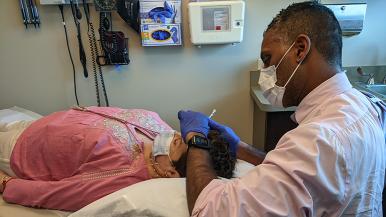Elvia “Pati” Araujo-Drzewiecki, 66, has been getting severe migraines since she was a child. She estimates that she gets 20 to 25 headaches a month.
“I go to bed with pain, and I wake up with pain,” she says.
Pati has tried many things to prevent her headaches. She drinks lots of water, watches what she eats and stays away from certain foods that might be triggers, like blackberries and blueberries, red wine and chocolate. She limits her time on the computer and phone and tries to avoid getting upset. She also wears dark sunglasses when outside.
“I’ve learned what to do,” she says. Yet, despite these lifestyle adjustments, she still suffers from frequent headaches. Fortunately, she has found relief from Botox treatment for migraines.
Finding treatment close to home
For the last 10 years, Pati has been getting Botox treatment for migraines every three months. After relocating to Aurora last year, she needed to find a doctor in the area who performs the treatment. She was happy to discover that Saju Abraham, MD, a neurologist with Rush University Medical Group, offers the treatment at Rush Copley — just five minutes from her home.
Botox is a type of botulinum toxin that acts on the nervous system. The toxin is purified and used in tiny doses to temporarily reduce muscle contractions. For migraine treatment, it is injected into specific areas in small doses. The Food and Drug Administration approved its use as a treatment for chronic migraine in 2010.
Its potential for use as a migraine treatment was discovered when patients receiving Botox for cosmetic purposes reported that their headaches were better. Doctors don’t know exactly why it works to ease migraine pain, but Abraham says, “It’s incredible, a real life-saver for some patients.”
How the treatment works
Because it is a paralytic, Abraham says one explanation may be that it paralyzes the nerves. Another explanation is that it interferes with chemicals that are involved in pain transmission. After being injected, the Botox enters nerve endings, blocking the release of these chemicals and preventing the activation of pain in the brain.
The treatment is an option for patients who experience 15 or more headache days a month.
“The number of headache days a patient experiences is cut down by 50%, if not more,” Abraham says. He also notes that patients who had headaches every day have zero or only one or two headaches over several weeks.
The procedure takes about 15 minutes, and patients typically feel relief from headaches within a week or two. Because the effects last about three months, the injections are typically given four times a year. When starting this treatment, Abraham says it may take two series of injections (separated by three months) for the patient to experience maximum relief.
Pati’s experience
At Pati’s appointment, Abraham used a very thin needle to inject 31 doses of Botox into her forehead, shoulders, neck and back of her head. The injection itself feels like a pinprick, Pati says, but she felt some discomfort from the Botox itself.
Pati says the discomfort she felt is like the sting you feel when you get lemon juice in a cut. “It burns,” she says, and she feels it more in the back of her head and also in her shoulders. The discomfort lasts for several hours following the injections.
But, she is willing to endure the temporary discomfort from the injections for the relief this procedure provides. She estimates her headaches have been reduced 75%.
And that, she says, is “definitely worth it.”




